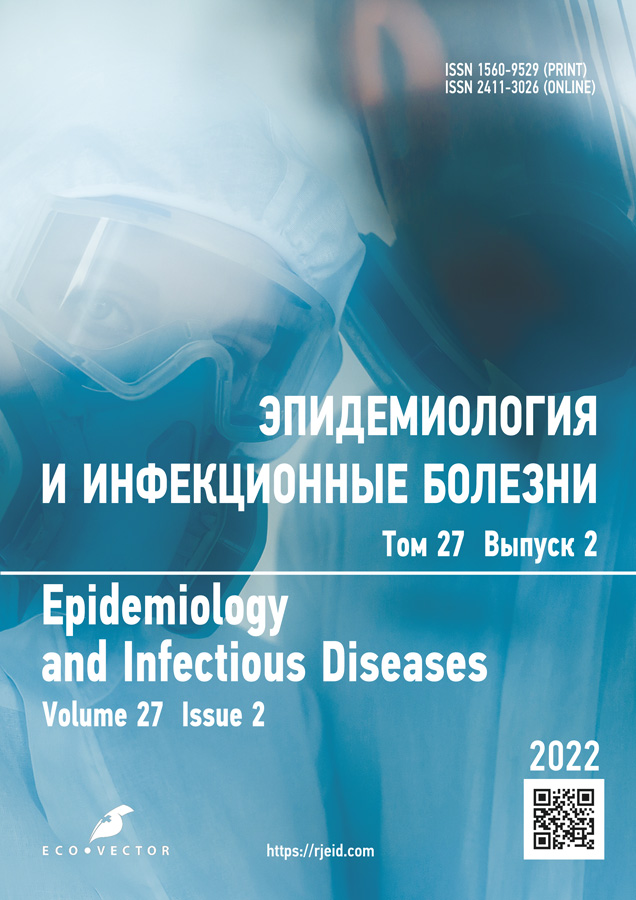Итоги мониторинга заболеваемости неполиомиелитной энтеровирусной инфекцией в допандемический и пандемический период
- Авторы: Даньшина Е.А.1,2, Миронов А.Ю.3,4, Суранова Т.Г.4, Куяров А.В.2
-
Учреждения:
- Центр гигиены и эпидемиологии в ХМАО — Югре
- Сургутский государственный университет
- Московский научно-исследовательский институт эпидемиологии и микробиологии имени Г.Н. Габричевского
- Академия постдипломного образования Федерального научно-клинического центра специализированных видов медицинской помощи и медицинских технологий
- Выпуск: Том 27, № 2 (2022)
- Страницы: 89-97
- Раздел: Оригинальные исследования
- Статья получена: 20.07.2022
- Статья одобрена: 19.09.2022
- Статья опубликована: 27.10.2022
- URL: https://rjeid.com/1560-9529/article/view/109422
- DOI: https://doi.org/10.17816/EID109422
- ID: 109422
Цитировать
Полный текст
Аннотация
Обоснование. Представлены итоги мониторинга заболеваемости неполиомиелитной энтеровирусной инфекцией в допандемический и пандемический период в Ханты-Мансийском автономном округе (ХМАО) — Югре (2011–2021).
Цель — проанализировать заболеваемость неполиомиелитной энтеровирусной инфекцией городского населения ХМАО — Югры за 2011–2021 гг.
Материалы и методы. Проведён ретроспективный анализ проявлений эпидемического процесса энтеровирусной инфекции, представлены результаты вирусологического мониторинга.
Результаты. Установлено, что самую большую долю в общей заболеваемости ЭВИ составляло городское население с преобладанием детей до 6 лет и школьного возраста. В период 2020–2021 гг. низкий уровень заболеваемости ЭВИ был обусловлен проводимыми противоэпидемическими мероприятиями в отношении COVID-19 и сопровождался распространением энтеровируса серотипа СVA6, способного эффективно реализовывать аспирационный механизм передачи возбудителя инфекции и вызывать респираторные и экзантемные заболевания. На распространение СVA6 повлияли рост миграционной активности населения вследствие частичного снятия ограничений и увеличение неиммунной прослойки населения, обусловленной снижением заболеваемости ЭВИ в 2020 г. Результаты проведённого исследования будут способствовать принятию мер к снижению уровня заболеваемости ЭВИ на территории ХМАО — Югры, рациональному планированию профилактических мероприятий путём совершенствования информационной и диагностической подсистем эпидемиологического надзора.
Заключение. Для решения поставленных задач необходимы дальнейшее изучение спектра циркулирующих на территории ХМАО — Югры энтеровирусов, частоты их встречаемости при субклинических формах ЭВИ и в качестве этиологических агентов энтеровирусного менингита, отработка методики молекулярно-генетического типирования с применением технологии массового параллельного высокопроизводительного секвенирования, изучение молекулярно-генетических характеристик. Всё это уменьшит риски заболеваемости ЭВИ в постпандемический период и обеспечит санитарно-эпидемиологическое благополучие населения и предупреждение распространения ЭВИ на территории ХМАО — Югры.
Полный текст
Об авторах
Екатерина Александровна Даньшина
Центр гигиены и эпидемиологии в ХМАО — Югре; Сургутский государственный университет
Email: kotya9530@mail.ru
ORCID iD: 0000-0002-3382-2161
SPIN-код: 7042-3503
Россия, Сургут; Сургут
Андрей Юрьевич Миронов
Московский научно-исследовательский институт эпидемиологии и микробиологии имени Г.Н. Габричевского; Академия постдипломного образования Федерального научно-клинического центра специализированных видов медицинской помощи и медицинских технологий
Email: andy.60@mail.ru
ORCID iD: 0000-0002-8544-5230
SPIN-код: 9225-1560
д.м.н., профессор
Россия, Москва; МоскваТатьяна Григорьевна Суранова
Академия постдипломного образования Федерального научно-клинического центра специализированных видов медицинской помощи и медицинских технологий
Email: suranovatatiana@mail.ru
ORCID iD: 0000-0003-3411-1027
SPIN-код: 7326-5273
кандидат медицинских наук, профессор кафедры инфекционных болезней и эпидемиологии Академии постдипломного образования
Россия, Москва
Александр Васильевич Куяров
Сургутский государственный университет
Автор, ответственный за переписку.
Email: kujarov@mail.ru
ORCID iD: 0000-0001-8388-9607
SPIN-код: 4821-0912
д.м.н., профессор
Россия, СургутСписок литературы
- Козловская О.В., Катанахова Л.Л., Камка Н.Н., Евсеева А.Н. Эпидемиологические, клинические и диагностические особенности энтеровирусной инфекции у детей и взрослых // Вестник СурГУ. Медицина. 2018. № 2 (36). С. 56–60.
- Bubba L., Broberg E.K., Jasir A., et al.; Enterovirus study collaborators. Circulation of non-polio enteroviruses in 24 EU and EEA countries between 2015 and 2017: a retrospective surveillance study // Lancet Infect Dis. 2020. Vol. 20, N 3. P. 350–361. doi: 10.1016/S1473-3099(19)30566-3
- Голицына Л.Н., Зверев В.В., Селиванова С.Г., и др. Этиологическая структура энтеровирусных инфекций в Российской Федерации в 2017–2018 гг. // Здоровье населения и среда обитания – ЗНиСО. 2019. № 8. С. 30–38. doi: 10.35627/2219-5238/2019-317-8-30-38
- Жукова Л.И., Рафеенко Г.К., Шагина А.Ф., Ванюков А.А. Многолетний эпидемиологический мониторинг и клиническая характеристика неполиомиелитных энтеровирусных инфекций в Краснодарском крае // Эпидемиология и инфекционные болезни. Актуальные вопросы. 2021. Т. 11, № 2. С. 9–11. doi: 10.18565/epidem.2021.11.2.22-8
- Лобзин Ю.В., Скрипченко Н.В., Мурина Е.А. Энтеровирусные инфекции: руководство для врачей. Санкт-Петербург: НИИДИ, 2012. 432 с.
- Медицинская микробиология, вирусология и иммунология / под ред. А.А. Воробьёва. 3-е изд. Москва: МИА, 2022. 704 с.
- Даньшина Е.А., Куяров А.В., Сайгушева Л.А., Распространённость энтеровирусной инфекции у жителей урбанизированного Севера. Инфекционные болезни в современном мире: эпидемиоло гия, диагностика, лечение и профилактика // Сборник трудов XII Ежегодного Всероссийского интернет-конгресса по инфекционным болезням с международным участием / под ред. В.И. Покровского. Москва, 2020. C. 67.
- Korukluoglu G., Ozdemirer U., Bayrakdar F., et al. Detection of non-polio and polio enteroviruses in Acute Flaccid Paralysis surveillance in Turkey // Acta Microbiol Immunol Hung. 2021. Vol. 68, N 2. P. 92–98. doi: 10.1556/030.2021.01353
- Никифоров В.В., Суранова Т.Г., Миронов А.Ю., Забозлаев Ф.Г. Новая коронавирусная инфекция (COVID-19): этиология, эпидемиология, клиника, диагностика, лечение и профилактика. Москва: Академия постдипломного образования ФГБУ «ФНКЦ ФМБА России», 2020. 55 с.
- Tamura K., Peterson D., Peterson N., et al. MEGA5: molecular evolutionary genetics analysis using maximum likelihood, evolutionary distance, and maximum parsimony methods // Mol Biol Evol. 2011. Vol. 28, N 10. P. 2731–2739. doi: 10.1093/molbev/msr121
Дополнительные файлы









